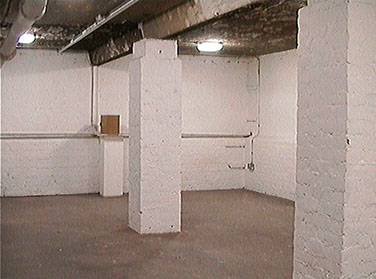Fine Art Department, University of Newcastle
17th and 18th October 2002
Archive information is at: the connecting principle

Documentation of such site-specific work with its implicit focus on the real-time presence of the viewer/listener within the active installation presents significant problems - a recording is an inaedequate representation of the experience in the moment - you had to be there.
| A
documentary fragment of a moment
within the installation, recorded on 21 October 2002 click on the speaker image |
 |
Original proposal, July 2002:
This proposal is to amplify the dark space beneath the stairs in the Fine Art Department at Newcastle using the principles expanded in my AHRB proposal (http://www.stalk.net/piano/proposal.htm), taking the sounds in the space and allowing people within that space to hear the space in a qualitatively different way over a few days. Various techniques are employed to allow the resonant frequencies of a room to become audible in real time - see Appendix below. This process is modulated by acoustic changes as people move around the space, by ambient sound, by humidity, by the movement of air.
Considerations with this particular installation will include the visual appearance of the space - lighting etc, a prime concern is to clarify the process at work.
It is my intention to set up the installation at some point during the summer, this should sort out any technical problems and make the eventual October version simpler and quicker to re-install in a configuration more likely to fit the overall context of this exhibition.
Appendix - Technology:
The basic system components of the installations are a microphone connected to a noise gate (in principle a switch which activates according to the volume of sound passing through it), amplifier and speakers in a highly reverberant room. The system is arranged in such a way that when the microphone and loudspeaker begin to feed back the amplitude of the sound causes the noise gate to cut off the signal. The feedback notes resonate through the space accentuated by the reverberation time of the space. As the sound falls below the threshold of the noise gate the system switches back on and the process continues.
The available pitches of the sound are primarily determined by the distance between the wall, floor and ceiling surfaces in the space, and by the location of microphone(s) and loudspeaker(s); by the time it takes a sound to travel and be reflected in three dimensions; not a simple equation. Microphones are Pressure Zone type to enable the plane of a room surface to act microphonically.
Equipment will be supplied by myself and the University.
| The Connecting Principle - origins University of Newcastle Fine Art Building |
 |
return
to:
Installations
Activated Space
© David Cunningham 2003